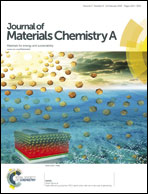Graphene below the percolation threshold in TiO2 for dye-sensitized solar cells
Abstract
We demonstrate a fast and large area-scalable methodology for the fabrication of efficient dye sensitized solar cells (DSSCs) by simple addition of graphene micro-platelets to TiO2 nanoparticulate paste (graphene concentration in the range of 0 to 1.5 wt%). Two dimensional (2D) Raman spectroscopy, scanning electron microscopy (SEM) and atomic force microscopy (AFM) confirm the presence of graphene after 500 °C annealing for 30 minutes. Graphene addition increases the photocurrent density from 12.4 mA cm−2 in bare TiO2 to 17.1 mA cm−2 in an optimized photoanode (0.01 wt% graphene, much lower than those reported in previous studies), boosting the photoconversion efficiency (PCE) from 6.3 up to 8.8%. The investigation of the 2D graphene distribution showed that an optimized concentration is far below the percolation threshold, indicating that the increased PCE does not rely on the formation of an interconnected network, as inferred by prior investigations, but rather, on increased charge injection from TiO2 to the front electrode. These results give insights into the role of graphene in improving the functional properties of DSSCs and identifying a straightforward methodology for the synthesis of new photoanodes.


 Please wait while we load your content...
Please wait while we load your content...